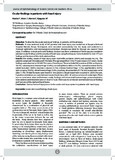| dc.description.abstract | Objective: To describe the ocular and visual findings in patients with head injury.
Methods: A cross-sectional study of 147 patients with head injury was carried out at Kenyatta National Hospital, Nairobi, Kenya. Participants were recruited consecutively into the study and underwent a thorough ophthalmic and neurosurgical examination. Analysis was done for the age, sex, cause of head injury, in addition to visual and ocular findings. Analysis was done to determine if there was any correlation between ocular findings and the severity of head injury using the Glasgow Coma Scale (GCS), brain CT scan
findings and fractures of the skull, orbit and face.
Results: The leading causes of head injury were road traffic accidents (44.9%) and assaults (42.2%). The patients comprised 136 males and 11 females. The age ranged from 18 to 77 years (mean=33.7 years). Ocular
findings were observed in 101(68.7%) cases of head injury. These included lid laceration (8.9%), ecchymosis (36.1%), subconjuctival haemorrhage (13.9%), corneal epithelial defects (16.7%), corneal laceration (0.6%),
scleral laceration (0.6%), traumatic cataract (1.1%), vitreous haemorrhage (1.1%), papilloedema (4.4%), optic atrophy (10.6%), retinal haemorrhage (5.6%), pupillary abnormalities (21.7%) and oculomotor nerve palsy (1.1%). Orbital fractures were found in nine patients. Visual impairment occurred in 52(29.2%) eyes. A positive correlation was seen between severe head injury (GCS <8) and occurrence of ocular signs. There was no correlation observed between ocular findings and intracranial haemorrhage, pneumocephalus,
brain oedema and infarctions seen on brain CT scan. There was no correlation seen between ocular findings and fractures of the skull and facial bones.
Conclusion: Various forms of injury occur to the ocular and visual system in patients with head injury. | en_US |

